Main Model

Zone C : Distal tubule

The renal corpuscle, also known as a Malpighian corpuscle, is the
essential portion of the nephron. It consists of a renal glomerulus and
Bowman's capsule. The corpuscle has two poles: the vascular pole and
urinary pole. At the vascular pole, the afferent arteriole (which
supplies the capillary network of the glomerulus) enters, and the
efferent arteriole (which collects the blood from the capillaries)
leaves the corpuscle. The urinary pole is the beginning of the proximal
convoluted tubule; it is continuous with Bowman's space.
The distal convoluted tubule is situated between the straight part of the proximal tubule and the collecting tubule, and is composed of a straight part and a distal convoluted part. The epithelial cells lining the distal convoluted tubule are cuboidal, with a round nucleus and basal striations at the base of the cells. The distal convoluted tubule is responsible for the resorption of sodium, an activity that is promoted by the hormone aldosterone. At the portion of the distal convoluted tubule contacting the parent renal corpuscle between afferent and efferent arterioles, the epithelial cells become densely packed, with the nuclei close together. Thus the region appears darker and is known as macula densa. The macula cells are immediately adjacent to the afferent and efferent arterioles, to the juxtaglomerular cells, and to the extraglomerular mesangial cells. These three cell groups together are called the juxtaglomerular apparatus.